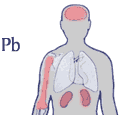
Nitrogen Dioxide

Ozone

Carbon Monoxide

Sulfur Dioxide

Particulate Matter

Lead
|
 
Lead - Pb
Lead is a metallic element that occurs naturally in soil, rocks, water, and food. Lead has been and still is added in concentrated quantities to various substances that we used in the past or still use now.
Where
Two of the major pollution sources of lead, leaded gasoline and leaded household paints which were responsible for significant levels of lead in our food, our air and our environment have been eliminated. In fact, since the mid-1970's, lead emissions have been reduced over 90%. This success story for cleaner air was a direct result of lead reduction in gasoline required by ARB and EPA regulations. However, some kinds of gas, primarily for small planes and race cars, still contain lead. Although it has been banned from house paints, lead is still added to some paints like industrial coatings. It is used in lead-acid car batteries, and at least 70% of the emissions that are still a problem come from industrial sources including smelters, coal-fire plants, and oil shale production processes.
Effects
Lead compounds can adversely affect human health through either ingestion of lead-contaminated soil, water, dust, paint, and food, or direct inhalation. Lead particles small enough to be inhaled into the lungs are readily absorbed into the blood and circulated throughout the body. The most important target of lead is the brain. At relatively low levels, lead exposure can result in increased blood pressure and permanently decrease the IQ of children. At higher levels, anemia can occur in both adults and children.

Back to Criteria Pollutants in Depth
|

Lead attacks the brain, the blood and the kidneys
Note: Since the mid-1970's, the U.S. has reduced lead emissions by over 90%--our most dramatic success thus far in the struggle for cleaner air. This is mainly due to eliminating lead from most gasoline sold in the U.S. Because lead emissions have been virtually eliminated from transportation sources, only industries like smelters, battery plants, and solid waste disposal still emit lead pollution. Since there are few of these sources in the western U.S., lead is not a big problem in California.
|
